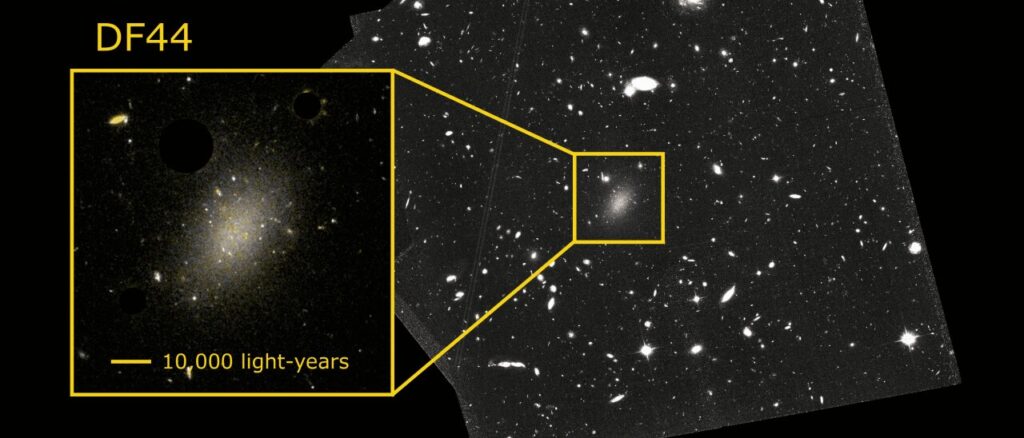An international team of researchers led by the Kapteyn Institute of the University of Groningen has found that the total number of globular clusters around Dragonfly 44 (the strange anomalous galaxy) is much less than earlier findings had suggested. This tells that the previous estimates of dark matter in the galaxy were wrong.
With years of data, scientists have measured that the dark matter around the galaxies usually varies between 10 and 300 times the quantity of visible matter. However, the discovery of Dragonfly 44 baffled scientists as it was observed that this galaxy has 10,000 times more dark matter than its visible matter.
The results recently appeared in the Monthly Notices of the Royal Astronomical Society (MNRAS).
Dragonfly 44
A few years ago, while astronomers were studying the Coma cluster, they found a diffused galaxy, named Dragonfly 44. It was found that this galaxy has 10,000 times more dark matter than the stars.
Astronomers believed that dark matter varies between 10 and 300 times the quantity of visible matter and that is what data suggested. But this galaxy was found to have 10,000 times more dark matter which is almost 100 times more than expected. So, the discovery of Dragonfly 44 was revolutionary.
But soon after that, researchers started investigating into it and the mystery seems to be finally solved.
The researchers did an exhaustive analysis of the system of globular clusters around Dragonfly 44. They have detected that the total number of globular clusters is only 20 and that the total quantity of dark matter is around 300 times that of the luminous matter. This means that it is not anomalous at all and is in the normal range only.
“The fact that in our work we found only 20 globular clusters, compared with the 80 previously claimed, reduces drastically the amount of dark matter which the galaxy is believed to contain,” explains Ignacio Trujillo, an IAC researcher and a co-author of the article. “Moreover, with the number of globular clusters we found, the amount of dark matter in Dragonfly 44 is in agreement with what is expected for this type of galaxies. The ratio of visible to dark matter is no longer 1 in 10,000 but one in 300,” adds Trujillo.
“Dragonfly 44 has been an anomaly all these years that could not be explained with the existing galaxy formation models. Now we know that the previous results were wrong and that DF44 is not extraordinary. It is time to move on,” points out Teymoor Saifollahi, a researcher at the Kapteyn Institute and the first author of the article.
The work shows that Dragonfly 44 is not so singular nor unexpected. The models of galaxy formation can explain it without any modification now says Michael A. Beasley, another IAC researcher and a co-author of the article.
Journal Reference:
Teymoor Saifollahi, Ignacio Trujillo, Michael A Beasley, Reynier F Peletier, Johan H Knapen. The number of globular clusters around the iconic UDG DF44 is as expected for dwarf galaxies. Monthly Notices of the Royal Astronomical Society, 2020; DOI: 10.1093/mnras/staa3016
Press Release: Instituto de Astrofísica de Canarias (IAC)

